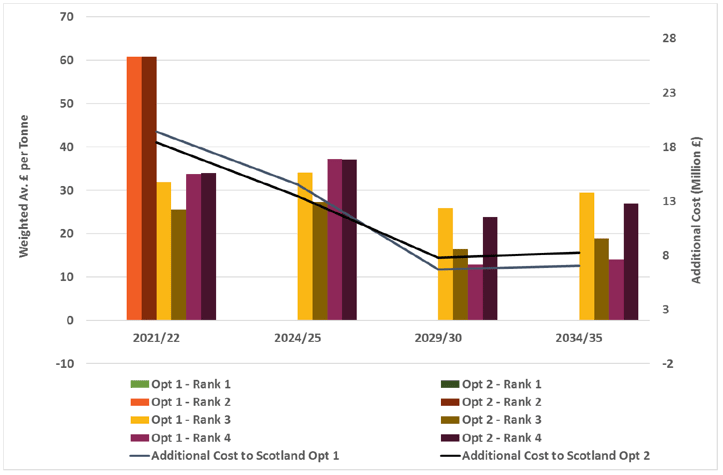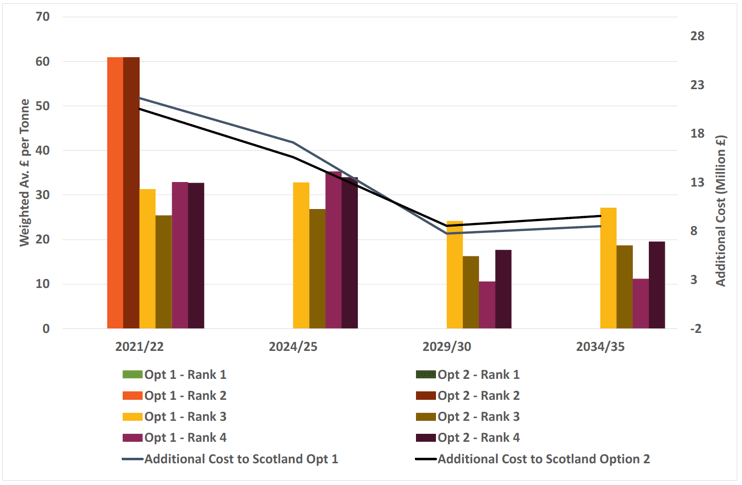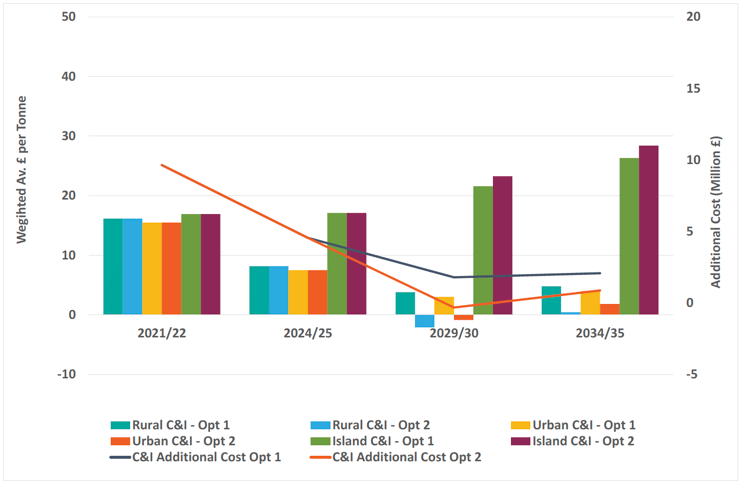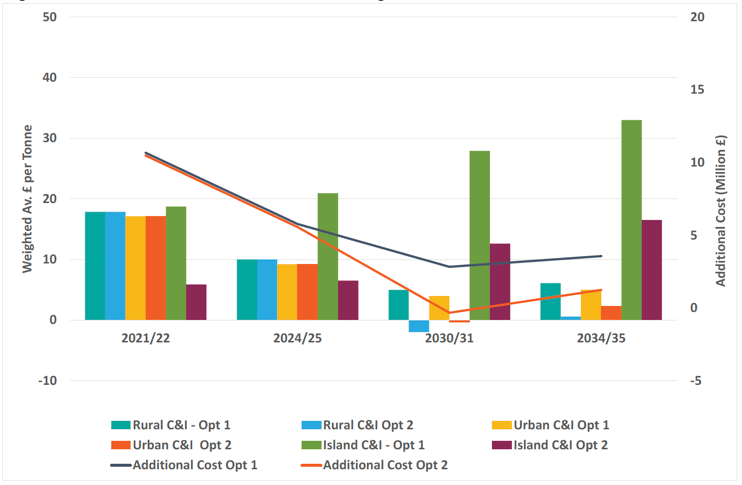Waste markets study: full report
Study regarding treatment options for Scottish biodegradable municipal waste.
Financial Modelling
In order to understand the financial costs associated with each option to both Scottish local authorities and the Scottish C&I sector, financial modelling was undertaken to determine the likely marginal costs for each option under each scenario.
Methodology
Modelling Approach
To assess the financial impact of the landfill ban in respect of residual waste, the costs for household and private collected waste at an authority level have been modelled against the baseline (i.e. where all material goes to the current, or currently planned, treatment/disposal solution).
All of the costs in the financial modelling have been presented in nominal terms and include taxation. The costs considered are the gate fee for the treatment or disposal of material and the transfer and haulage costs to the point of disposal or treatment. The following section details the assumptions used when modelling the financial costs of the landfill ban.
Option Assumptions
In both options, it has been assumed that Scottish thermal and other residual treatment plants fully utilise local authority feedstocks. C&I waste is only assumed to be a feedstock where there is additional capacity, beyond that required for local authority household waste, in remote locations where other councils are unlikely to send waste.
Option 1 Assumptions
In this option, no further thermal treatment capacity is developed beyond what is currently operational, under construction, or reaching financial close. All residual waste not served by treatment capacity expected to be developed by 2025/26 will be exported to English thermal treatment/landfill or as RDF to Europe.
The total amount of waste requiring treatment outside of Scotland for the 14 years of the modelled period (from 2021 to 2035) is:
- Scenario 1 – 5.6 million tonnes; and
- Scenario 2 – 16.2 million tonnes.
The modelling relies on the ranking given to local authorities, explained above. In both scenarios, we have made assumptions about the solution most likely to be adopted by each rank 2, 3 and 4 authority – those that will not have thermal treatment in place by 2021 and so have an uncertain position in the short term, the long term, or both. Initially, these authorities produce some 538k tonnes of residual waste per year.
Authorities closest to port facilities in Edinburgh or Aberdeen are assumed to make use of European export markets whereas authorities close to the border were assumed to export to English capacity.[9] In both scenarios, C&I waste generation from Northern Scotland and around Edinburgh are assumed to be exported as RDF, while waste generated near the border is exported to England.
Option 2 Assumptions
For scenario 1, it is assumed that sufficient treatment capacity is developed to treat the 87,000 tonnes of residual waste per annum anticipated to arise when all targets have been met in 2035. In scenario 2 it is assumed that 1.146 million tonnes per annum of treatment capacity will be required. It is assumed that this additional capacity will come online in 2025/26.
In order to model the logistics and potential transport costs associated with this option, a high-level assessment was undertaken to determine potential locations for the development of additional thermal treatment infrastructure within Scotland. This was informed by the location of:
- existing/under development/committed thermal treatment;
- local authorities that do not currently have solutions in place to address the ban (rank 2 3, and 4 authorities); and
- major population centres.
For scenario 1, it is assumed that one additional treatment facility would be located in central Scotland.
For scenario 2, it is assumed that two additional treatment facilities would be located in Central Scotland with a third located in Northern Scotland.
In both scenarios, where no specific information is available, assumptions have been made regarding the interim solutions adopted by rank 2, 3 and 4 authorities until sufficient additional capacity is available. Authorities closest to Edinburgh or Aberdeen were assumed to make use of European export markets whereas authorities closest to the border were assumed to export to England[10].
It is assumed that waste is hauled to the nearest facility, with haulage costs and associated impacts modelled accordingly.
For both scenarios, it is assumed that Scotland continues to have access to at least the amount of overseas treatment capacity that it currently makes use of. This is consistent with other scenarios, and reflects the overseas treatment capacity already secured by Scottish waste collectors. However, RDF exports may increase above that level as a result of the policy, resulting in additional capacity needing to be secured to treat Scottish waste.
Gate Fee Assumptions
Wherever possible, gate fees have been based on information provided through local authority and commercial waste sector interviews. However, concerns regarding commercial confidentiality limited the extent to which interviewees were willing to supply this information.
It is expected that the ban will result in initial disruption to the market. In the current market, the need to compete with landfill helps limit the gate fees of waste treatment and export. The ban will effectively remove this restriction; instead, English landfill costs (inclusive of haulage) are likely to act as the market restriction post-2021. This is likely to allow an increase in gate fees for other treatment routes, whether RDF exports to Europe or treatment capacity in England. After an initial peak, prices are expected to level out over the medium-long term due to a rebalancing in the market and increased competition. Gate fee assumptions are provided in more detail in Appendix 5.
For options involving thermal treatment development, it is assumed that the capital development costs are covered though PPP arrangements and reflected within the gate fee.
Transport Costs Assumptions
Based on 2018 figures, Table 6 sets out the haulage costs that have been assumed. Only road and ship haulage has been considered within the scope of this work as the availability of rail networks accessible to waste infrastructure is unknown. Rail haulage may be feasible and cost effective where an authority's transfer infrastructure and subsequent facility offloading infrastructure is located sufficiently near to rail heads/sidings. Unless this requisite infrastructure is already in place, establishing it would only be viable in the context of a medium-long term contract. Even in favourable circumstances, rail is only likely to be competitive with road haulage over relatively long distances.
Table 6: Transport Cost Assumptions (2018)
| Transport Type | Assumptions (/t/mi) | Source |
|---|---|---|
| Road | £0.15 | Eunomia R&C industry knowledge |
| Ship | £0.55 | Eunomia R&C industry knowledge |
| Road & Ship | £0.28 | Assumed 1/3 ship transport and 2/3 road transport for 'Island' |
Results
The following sections present the marginal cost modelling for each option under each scenario. The analysis looks only at the costs of residual waste treatment and does not account for any costs/savings associated with any increase in recycling performance.
Household Waste
Figure 7 shows the marginal costs for household waste in cash terms under a recycling rate-compliant scenario. Figure 8 shows marginal costs in cash terms for household waste under a business as usual scenario.
The bar graphs show the marginal per tonne costs based on an authority's 'state of readiness' rank as categorised above. The line graphs show the overall marginal costs to Scotland for household waste.
In both scenarios, both options result in a significant increase in overall cash costs of managing household residual waste compared with the price of landfill. The overall marginal costs are likely to be lower where additional thermal treatment capacity is developed in the short-medium term; however, as the market levels following an initial shock, the option to export becomes more favourable as a result of RDF export gate fees becoming more competitive.
In both scenarios, for rank 1 authorities, there will be no impact on marginal costs per tonne as a result of the landfill ban policy as they have already secured contracts. However, for authorities that have not yet secured contracts, the landfill ban policy is likely to have a significant impact upon marginal costs per tonne.
- Rank 2 authorities see the highest short-term marginal cost. This is because the authorities in this rank currently rely on landfill and will need to go to the market to secure very short-term export contracts just as the ban takes effect. Because of their northerly location, they are unlikely to be able to leverage alternative options to secure low gate fees, and so are likely to face relatively high-cost interim contracts. However, as they are already committed to long term thermal treatment contracts, the landfill ban policy will not impact their marginal cost per tonne once their treatment infrastructure comes online.
- In the short term, the cost increases for rank 3 and 4 authorities that don't have a long-term solution in place are likely to be lower than those for rank 2 authorities, due to their geographical location and their ability to go to the market at a more favourable time. In the medium- and long-term, these authorities will experience additional costs as a result of the policy, although these will be lower than those initially visited on rank 2 authorities, as the export market is expected to gradually re-balance.
In both scenarios, for most authorities, if Scotland builds additional thermal treatment capacity it will result in a slightly smaller increase in marginal cost per tonne than export options in the short and medium-term. The short-term savings result from councils being less likely to need to invest in additional waste transfer and processing facilities if they plan to make use of domestic facilities, an investment that would be required if they propose to make long-term use of export options. However, as the market stabilises, the option to export will become more favourable.
Figure 7: Scenario 1: Recycling Policy Compliant - Marginal Costs for Household Waste

In both scenarios, the marginal cost per tonne is likely to be slightly higher for rural authorities, and significantly higher for island authorities. This is primarily due to the effect of transport costs.
Figure 8: Scenario 2: Business as Usual - Marginal Costs for Household Waste

Commercial & Industrial Waste
Figure 9 shows the marginal cost for the C&I waste sector under a recycling rate-compliant scenario. Figure 10 shows the marginal costs for the C&I waste sector under a business as usual scenario.
In both scenarios, the overall marginal costs to the Scottish C&I market are likely to significantly increase at the point at which the ban comes in. There is a decreasing overall marginal cost trend up to 2030 in both scenarios as the market starts to level and, in scenario 1, recycling rates increase. However, in option 2 where additional Scottish thermal treatment capacity is developed, lower overall marginal costs will likely be experienced by the sector as treatment infrastructure capacity becomes available at more competitive gate fees than export markets. This presumes that additional capacity has a downward influence on gate fees in the areas of Scotland that it would be likely to serve, but also relates to the fact that new Scottish thermal treatment facilities would presumably be procured by Scottish local authorities. Through such procurement processes it should be possible to secure lower gate fees in return for long term waste supply. This effect is more pronounced in scenario 2 as a result of the greater quantity of waste requiring treatment.
Unsurprisingly, in both scenarios, the marginal cost per tonne is likely to be slightly higher for rural C&I waste, and significantly higher for waste arising on islands, than for urban providers. This is primarily due to the effect of transport costs.
In both scenarios, for rural and urban C&I markets, the marginal costs per tonne are expected to decrease in comparison to the baseline for option 2 as Scottish thermal treatment capacity comes online and the market is able to secure favourable gate fees in comparison to export options. This effect is not seen in the islands markets, as no new capacity is assumed to be brought on stream in these areas.
Figure 9: Scenario 1: Recycling Policy Compliant – Marginal Costs for C&I Waste

Figure 10: Scenario 2: Business as Usual - Marginal Costs for C&I Waste

The additional costs may create issues for some private operators that have a relatively marginal business, especially if they are subject to competition from larger, vertically integrated collectors that are better protected from landfill closure. In the event that the landfill ban makes it unviable for some private sector collectors to collect commercial waste, the market may be affected.
- In some areas, the number of different collectors may decrease. Additional costs and reduced competition may mean that prices for customers increase.
- Some customers may need to change contractor.
- Local authorities that collect C&I waste may see an increase in customers; but those that do not currently collect it may find themselves called upon to take a more active role in fulfilling their duty to arrange for commercial waste collections in their area if requested to do so.
Contact
Email: eqce.cezw@gov.scot
There is a problem
Thanks for your feedback